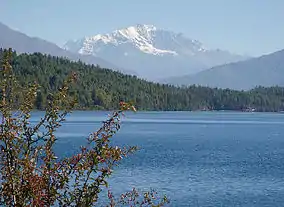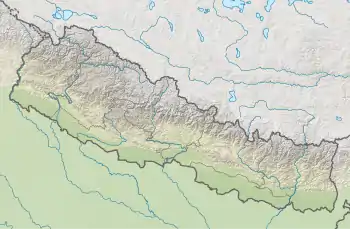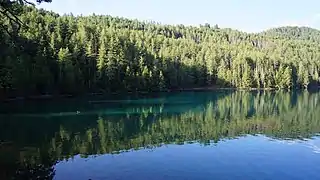Rara National Park
Rara National Park is a protected area in the Himalayas of Nepal and was established in 1976. Covering an area of 106 km2 (41 sq mi) in the Mugu and Jumla districts, it is the country's smallest national park. Its main feature is Rara Lake at an altitude of 2,990 m (9,810 ft).[1] The park was established to protect the unique flora and fauna of the Humla–Jumla Region of Nepal.
| Rara National Park | |
|---|---|
IUCN category II (national park) | |
 Rara Lake | |
 | |
| Location | Nepal |
| Nearest city | Jumla |
| Coordinates | 29°30′40″N 82°03′02″E |
| Area | 106 km2 (41 sq mi) |
| Established | 1976 |
| Governing body | Department of National Parks and Wildlife Conservation |


The park ranges in elevation from 2,800 m (9,200 ft) to 4,039 m (13,251 ft) at Chuchemara Peak on the southern side of Rara Lake. On the northern side, the peaks of Ruma Kand and Malika Kand frame the alpine freshwater lake, which is the largest lake in Nepal with a surface of 10.8 km2 (4.2 sq mi) and a maximum depth of 167 m (548 ft). It is oval-shaped with an east–west axis, a length of 5 kilometres (3.1 mi) and a width of 3 km (1.9 mi) draining into the Mugu-Karnali River via Nijar Khola.[1]
Rara National Park is managed by the Department of National Parks and Wildlife Conservation and protected with the assistance of the Nepal Army.
Climate
The climate of Rara National Park is pleasant during the summer, but becomes very cold during the winter, because of the altitude. The best times to visit the park are in September, October, April, and May. During the winter, temperatures drop below freezing, and many high passes become blocked by snow. The summer is warm, but June to August is monsoon season, making the trek to Rara National Park difficult.
Vegetation
One thousand and seventy species of flora are estimated from Rara National Park. Rhododendron, fir, brown oak, and birch species are found in the sub-alpine region.[1] Below 3,200 m (10,500 ft), the vegetation consists of mainly blue pine (Pinus excelsa), rhododendron (Rhododendron arboretum), west Himalayan spruce, black juniper and Himalayan cypress. Above 3,200 metres (10,500 ft), the vegetation changes to a coniferous forest consisting of a mixture of fir, spruce and pine.
Fauna
Fifty-one species of mammals, 241 species of birds, two species of reptiles and amphibians, and three species of fish have been recorded from the park including musk deer, red panda, snow leopard, Himalayan black bear, Indian leopard, jackal, Himalayan tahr, yellow-throated marten, otter, dhole, gray langur, and rhesus macaque.[1]
There are 241 recorded species of birds, including 49 wetland species. Coots are often found in the lake. During the winter, great-crested and black-necked grebes, red-crested pochards, mallard, common teal (Anas crecca), and common merganser are common. Other birds seen often include the Himalayan snowcock, chukar partridge, Himalayan monal, kalij pheasant and blood pheasant.[1]
In 1979, three endemic snowtrout species were collected in Lake Rara and described as new species: the Nepalese snowtrout Schizothorax nepalensis, the Rara snowtrout, and Nepalese snowtrout.[2] Also in 1979, the frog species Paa rarica has been first recorded as endemic to the lake.[3]
Tourism
Rara is budding as a tourist destination. There is little accommodations within the park. Visitors can fly from Kathmandu to Nepalgunj, followed by a flight to Talcha. From there, Rara lake can be reached in a few hours by walking. Rara National Park is an interesting destination for many interested in seeing various flora, fauna, and scenery unique to the area.
GORP founder Bill Greer described Rara Lake as:
- "a shimmering blue jewel set in a ring of snowy peaks"[4]
Another travel writer describes a trek in the park:
- "Although more trampled than in the past, the road to Rara Lake is still without any of the comfortable services available along more popular trails. Logistically it is not an easy trek; it is hard to get to and from, and it is an organizational challenge, requiring informed guides and porters to tote the two weeks' worth of material that will keep you warm, dry and fed. It is also tough on the bones, involving several 11,000-foot passes. However, once you overcome the obstacles, the rewards are legion: few if any other trekkers, incomparable natural splendor, "untouched" villages, blissful quiet…"[4]
There are no settlements within the boundaries of Rara National Park, as the two villages once inside the area, Rara and Chhapru, were resettled in the Banke District when the protected area was established. Agriculture is the basis for the local economy in the surrounding areas, which has led to pollution inside the park. Sediment from the surrounding hills as well as sewage and solid waste threaten the park.
References
- Bhuju, U. R., Shakya, P. R., Basnet, T. B., Shrestha, S. (2007). Nepal Biodiversity Resource Book. Protected Areas, Ramsar Sites, and World Heritage Sites (PDF). Kathmandu: International Centre for Integrated Mountain Development, Ministry of Environment, Science and Technology, in cooperation with United Nations Environment Programme, Regional Office for Asia and the Pacific. ISBN 978-92-9115-033-5.CS1 maint: uses authors parameter (link)
- Terashima, A. (1984) Three new species of the Cyprinid genus Schizothorax from Lake Rara, Northwestern Nepal. Japanese Journal of Ichthyology Vol. 31, No. 2: 122–135
- Dubois, A., Matsui, M. (1983). A new species of frog (Genus Rana, Subgenus Paa) from western Nepal (Amphibia: Anura). Copeia: 895–901.
- Gelber, E. Top Ten Treks in the Nepalese Himalaya